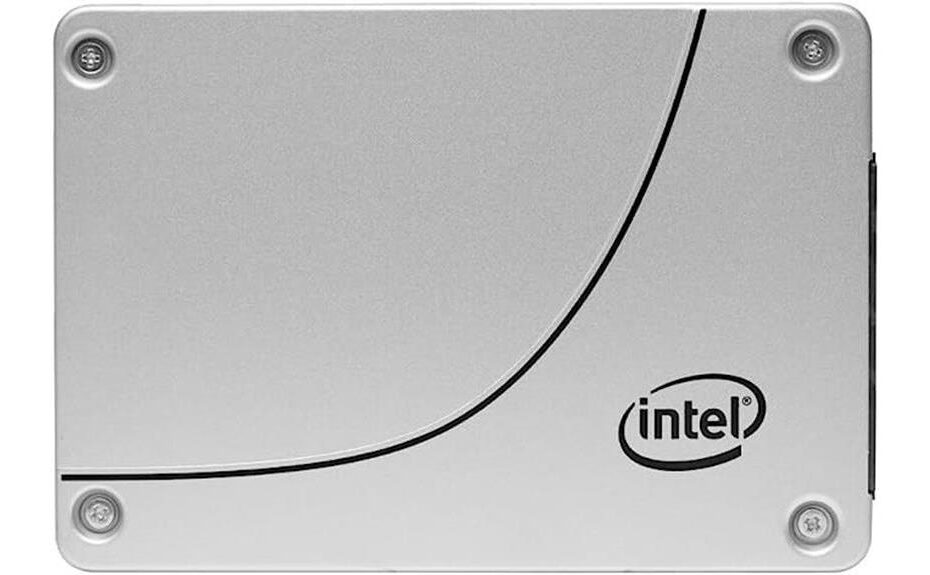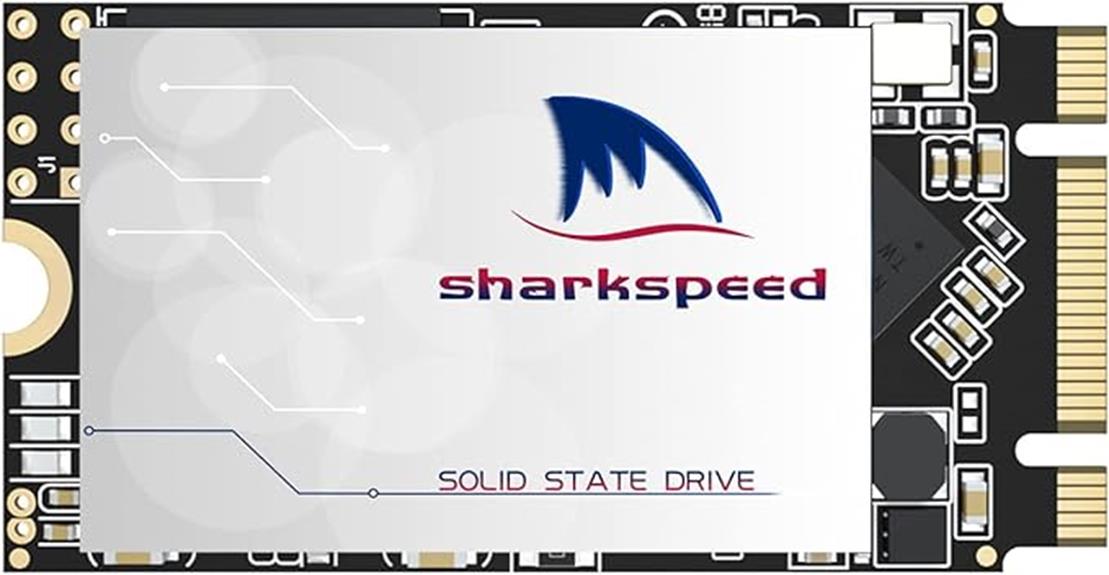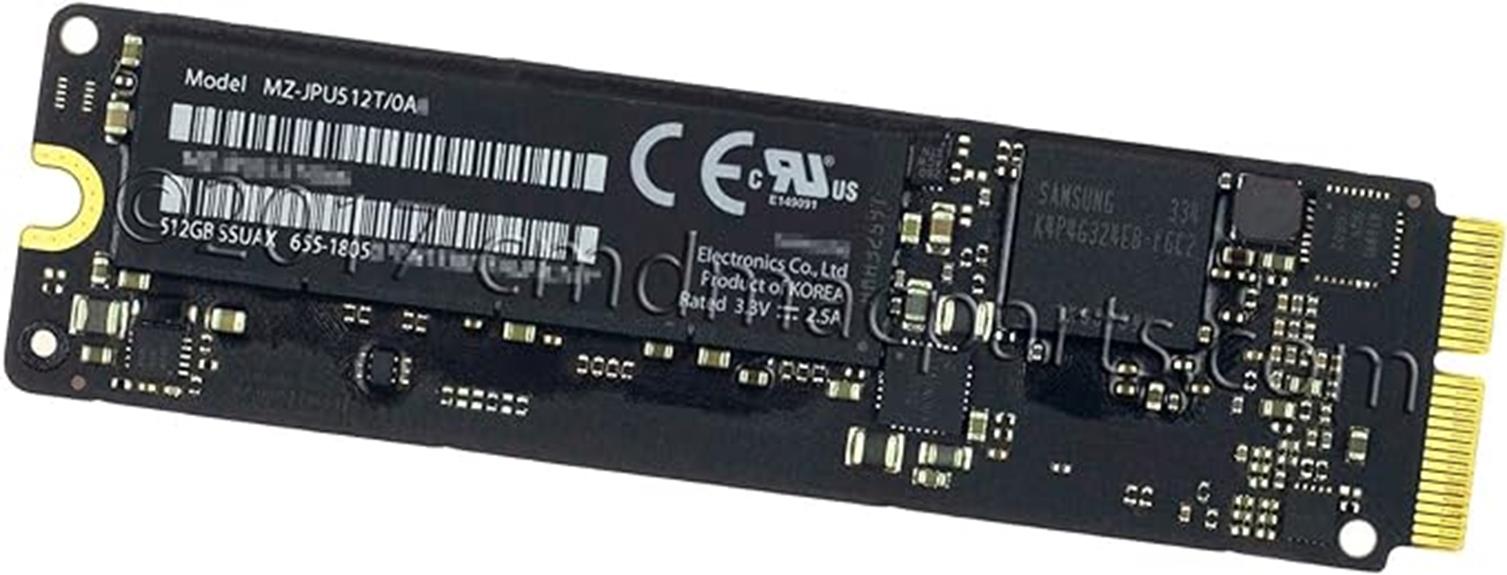The Intel SSD D3-S4510 promises impressive performance, boasting 97,000 IOPS and low latency of 36 microseconds. With a substantial storage capacity option of 3.84TB, it's ideal for high-IOPS workloads and server storage solutions. However, concerns about product quality, reliability, and performance issues have surfaced, with users reporting drive failures and excessive runtime hours. As we examine the features, benefits, and customer experiences, a vital question emerges: can the Intel SSD D3-S4510 truly deliver on its promises, or do its shortcomings outweigh its potential benefits?
Key Takeaways
- The Intel SSD D3-S4510 boasts high-speed random read IOPS performance of 97,000 and low latency of 36 microseconds.
- Concerns about product quality and reliability have been reported, including excessive runtime hours and read/write counts.
- The drive is ideal for server storage solutions and data centers, particularly suitable for high-demand applications requiring high-IOPS workloads.
- The 2.5-inch form factor SSD offers high capacity storage of 3.84TB and end-to-end data protection capabilities.
- Despite its impressive specifications, users have reported reliability issues, high read/write counts, and discrepancies between advertised and actual drive condition.
The Intel SSD D3-S4510, a 2.5-inch form factor SSD, boasts impressive performance specifications, including a latency of 36μs for reads and 37μs for writes, as well as random read and write IOPS of 97,000 and 32,000, respectively. These performance benchmarks suggest that the drive is well-suited for demanding applications. However, user installation experiences have been mixed. Some users have reported high read and write counts despite being labeled as new, while others have experienced drive failure after adding a heat sink. These issues have led to concerns about the drives' actual condition compared to the advertised status.
Features and Benefits
The Intel SSD D3-S4510 boasts an impressive array of features and benefits, starting with its exceptional high-speed random read IOPS performance, which enables rapid data access and retrieval. Additionally, its remarkably low latency of 36 microseconds guarantees swift response times, making it an attractive option for applications requiring high-speed data processing. Moreover, the drive's high capacity storage option and end-to-end data protection capabilities provide users with a reliable and secure storage solution.
High-Speed Random Read IOPS
Delivering exceptional performance, the Intel SSD D3-S4510 boasts an impressive 97,000 IOPS in random read operations, making it an ideal choice for applications that require rapid data access and processing. This high-speed random read IOPS capability enables the SSD to efficiently handle demanding workloads, ensuring swift data retrieval and processing. In a performance comparison with other SSDs, the Intel SSD D3-S4510 stands out with its remarkable random read performance, making it suitable for applications that require high-speed data access. Additionally, its scalability options allow for easy integration into various system configurations, further enhancing its appeal for data-intensive applications.
Low Latency of 36μs
Boasting an impressively low latency of 36 microseconds, the Intel SSD D3-S4510 guarantees rapid data access and processing, making it an appealing choice for applications that demand quick and effective data retrieval. This exceptional latency enables the SSD to excel in performance benchmarking, ensuring data integrity and minimizing the risk of data corruption. During installation, it is essential to follow the installation guide carefully to avoid compatibility issues, ensuring seamless integration with existing systems. The low latency of the Intel SSD D3-S4510 makes it an attractive option for applications requiring swift data access, such as data centers, cloud storage, and high-performance computing environments.
High Capacity Storage Option
How do high-capacity storage options, like the Intel SSD D3-S4510, address the increasing demands for data storage in modern applications? The answer lies in their ability to provide vast storage capacities while maintaining impressive performance benchmarks. In a storage capacity comparison, the Intel SSD D3-S4510 offers a substantial 3.84TB of storage space, making it an ideal solution for data-intensive applications. When it comes to performance benchmarks, this SSD boasts random read and write IOPS of 97,000 and 32,000, respectively, ensuring swift data access and transfer. With its high-capacity storage and exceptional performance, the Intel SSD D3-S4510 is well-suited to meet the demands of modern data storage requirements.
End-to-End Data Protection
The Intel SSD D3-S4510 incorporates advanced end-to-end data protection features, ensuring the integrity and security of data throughout its entire lifecycle, from creation to storage and retrieval. This extensive protection encompasses data encryption, which safeguards data from unauthorized access. Additionally, the drive's built-in error correction mechanisms detect and correct errors, ensuring data accuracy and reliability. The SSD's firmware is also designed to withstand power failures, preventing data corruption and loss. Moreover, rigorous performance testing has validated the drive's ability to maintain data integrity under various stress conditions. By combining these advanced features, the Intel SSD D3-S4510 provides a secure and reliable storage solution for demanding applications.
Product Quality
Moreover, Intel's SSD D3-S4510, promoted as a high-performance storage solution, falls short of expectations with subpar product quality, as evidenced by the excessive runtime hours and high read/write counts reported by multiple users. This raises significant reliability concerns and performance issues, undermining the product's overall value proposition. Additionally, the lack of transparency regarding the drives' actual condition and history has led to disappointment and mistrust among customers. It is essential for Intel to address these concerns by providing clear warranty coverage and robust customer support to mitigate these issues and restore customer confidence.
What It's Used For
The Intel SSD D3-S4510 is designed to excel in high-demand applications, making it an ideal choice for server storage solutions and data center deployments. Its exceptional random read and write performance, with IOPS reaching 97,000 and 32,000 respectively, make it particularly well-suited for high-IOPS workloads. Therefore, it is well-positioned to support demanding data center applications that require low latency and high throughput.
Server Storage Solutions
In high-performance computing environments, server storage solutions like the Intel SSD D3-S4510 play a critical role in ensuring rapid data access and efficient storage management. This is particularly important for organizations relying on server performance to meet demanding workloads. By leveraging the Intel SSD D3-S4510's high random read and write IOPS, businesses can notably enhance server performance, reducing latency and boosting overall system efficiency. Moreover, the drive's storage efficiency enables data centers to optimize storage capacity, minimizing overhead costs and maximizing resource utilization. By integrating the Intel SSD D3-S4510 into their server infrastructure, organizations can achieve improved data access times, increased productivity, and enhanced overall system reliability.
Data Center Applications
Data centers leveraging the Intel SSD D3-S4510's high-performance capabilities can optimize storage infrastructure for demanding workloads, including virtualized environments, cloud storage, and data analytics platforms. The drive's high IOPS and low latency enable efficient data processing, making it an ideal solution for data-intensive applications. Additionally, the Intel SSD D3-S4510's power efficiency reduces the overall power consumption of the data center, leading to significant cost savings. However, compatibility issues may arise when integrating the drive with existing infrastructure, highlighting the need for careful planning and testing. By addressing these potential issues, data centers can fully harness the Intel SSD D3-S4510's capabilities, ensuring seamless and efficient data processing.
High-IOPS Workloads
High-performance storage solutions like the Intel SSD D3-S4510 are particularly well-suited for high-IOPS workloads, where rapid data access and processing are paramount. In these environments, the drive's exceptional random read and write performance of 97,000 IOPS and 32,000 IOPS, respectively, enable swift data retrieval and processing. A performance comparison with other high-IOPS storage solutions reveals the Intel SSD D3-S4510's exceptional capabilities. When installing the drive for high-IOPS workloads, it is essential to follow proper installation tips, such as ensuring proper cooling and avoiding overheating, to maximize performance and longevity. By doing so, users can fully utilize the potential of the Intel SSD D3-S4510 and reap the benefits of high-performance storage in demanding applications.
Product Specifications
The Intel SSD D3-S4510 SSDSC2KB038T801 boasts a 2.5-inch form factor, accompanied by impressive latency specs of 36 microseconds for reads and 37 microseconds for writes. This SSD is designed for high-performance applications, offering a Random Read IOPS of 97,000 and Random Write IOPS of 32,000. For a comprehensive understanding of this SSD's capabilities, let's examine its key specifications:
| Specification | Value |
|---|---|
| Form Factor | 2.5 inch |
| Latency (Read/Write) | 36 μs / 37 μs |
| Random Read IOPS | 97,000 |
| Random Write IOPS | 32,000 |
In the context of performance analysis, the Intel SSD D3-S4510's specifications suggest it is well-suited for demanding workloads. Additionally, its compact form factor and low latency make it an attractive choice for installation in systems where space is limited.
Who Needs This
When considering high-capacity, low-latency storage solutions for demanding applications, the Intel SSD D3-S4510 emerges as an attractive option. This drive is particularly well-suited for organizations and individuals with high-performance computing needs, such as data centers, cloud storage providers, and enterprises requiring fast data access. The target audience includes IT professionals, system administrators, and developers who need reliable and efficient storage solutions. Regarding compatibility requirements, the Intel SSD D3-S4510 works with a wide range of systems, including servers, workstations, and data centers, making it an ideal choice for organizations with diverse infrastructure needs. With its impressive performance and capacity, this drive is an excellent fit for applications demanding high-speed data storage and retrieval.
Pros
With its exceptional random read and write IOPS, the Intel SSD D3-S4510 offers outstanding storage performance, making it an attractive solution for demanding applications that require fast data access. This is evident in its impressive performance analysis, boasting 97,000 IOPS for random reads and 32,000 IOPS for random writes. The user experience is also enhanced by the drive's fast latency, with read and write times of 36μs and 37μs, respectively.
Some notable benefits of the Intel SSD D3-S4510 include:
- Exceptional random read and write IOPS for fast data access
- Fast latency for improved overall system responsiveness
- High storage capacity for demanding applications
Cons
Several users have reported concerns regarding the actual condition of the Intel SSD D3-S4510, citing discrepancies between the advertised status and the reality of the drives' run time hours and usage. This has led to reliability concerns and doubts about the drive's performance. Specifically:
- Discrepancies between advertised and actual run time hours and usage
- Drives running hot and failing after adding a heat sink
- High read/write counts despite being labeled as new, affecting drive performance
These issues have raised concerns about the drive's reliability and overall performance, casting a shadow over the Intel SSD D3-S4510's otherwise impressive specifications.
What Customers Are Saying
Customer feedback and reviews have played a significant role in shaping the overall perception of the Intel SSD D3-S4510, with many users sharing their experiences and concerns about the drive's performance and reliability. A common thread among customer feedback is the discrepancy between the advertised status and the actual condition of the drives. Several users reported high read/write counts and run time hours, despite being labeled as new. Additionally, some users experienced drive failure after adding a heat sink, which raises concerns about drive reliability. These issues have led to disappointment and frustration among customers, highlighting the importance of verifying the drive's condition before purchase. Overall, customer feedback highlights the need for caution when purchasing the Intel SSD D3-S4510.
Overall Value
Considering the Intel SSD D3-S4510's performance capabilities, including its impressive 97,000 IOPS random read speed, the drive's overall value is largely influenced by the difference between its advertised status and actual condition, as reported by numerous customers. When it comes to performance comparison, the drive's specifications suggest it is a high-performing SSD. However, durability concerns arise when considering the reported issues with drive longevity and high runtime hours despite being sold as new. This dissonance heavily impacts the drive's overall value, making it vital to carefully evaluate the actual condition of the drive before making a purchase. As customers have reported, being cautious and vigilant is important to avoid disappointment and ensure a satisfactory purchase experience.
Tips and Tricks For Best Results
When installing and configuring the Intel SSD D3-S4510, it is essential to follow proper thermal management and handling practices to guarantee peak performance and longevity. Make sure the drive is installed in a well-ventilated area, away from heat sources, and consider using a heat sink to maintain ideal temperatures. For top performance, enable write caching and adjust the queue depth to optimize IOPS. Regularly update firmware and monitor drive health using Intel's toolset. When troubleshooting, check for loose connections, outdated drivers, and firmware issues. Additionally, monitor drive temperatures and adjust cooling accordingly. By following these installation tips and performance tweaks, users can maximize the Intel SSD D3-S4510's potential and minimize the risk of common issues.
Conclusion
In conclusion, the Intel SSD D3-S4510's impressive specifications, such as its 97,000 IOPS random read performance and 32,000 IOPS random write performance, are overshadowed by concerns regarding the drives' actual condition and warranty status. While the drive's performance comparison to other SSDs is favorable, the discrepancies between advertised and actual condition raise doubts about its reliability. Moreover, the warranty coverage seems uncertain, adding to the uncertainty. The user feedback and purchase experience highlight the importance of verifying the drive's condition and warranty before making a purchase. Ultimately, the Intel SSD D3-S4510's performance potential is hindered by the uncertainty surrounding its quality and warranty, making it essential to approach with caution.
Frequently Asked Questions
Can I Return a Modified Drive if It Fails?
When a modified drive fails, understanding the return policy and warranty terms is essential. Failure analysis and diagnosis are crucial to determine if drive tampering voids the warranty. Initiating the return process requires careful consideration of these factors to guarantee a successful outcome.
How Do I Verify the Authenticity of a New Ssd?
"Verifying authenticity is like cracking a code; start by inspecting the packaging for tamper-evident seals and look for a legitimate serial number that matches the manufacturer's database, ensuring a genuine product."
Are Refurbished SSDS Sold as New by Some Retailers?
Some retailers employ questionable reseller tactics, mislabeling refurbished SSDs as new, which can lead to deceptive SSD labeling, resulting in customers receiving used products with high runtime hours, compromising performance and reliability.
What Are the Signs of an SSD Nearing Its End-Of-Life?
SSDs nearing end-of-life exhibit signs of degradation, including increased data corruption, reduced life expectancy, and distinctive wear patterns, such as slowing write performance, frequent errors, and rising bad block counts, indicating imminent failure.
Can a Heat Sink Installation Void an Ssd's Warranty?
Installing a heat sink on an SSD can potentially void its warranty, as it may be considered a modification that alters the device's original thermal performance, triggering warranty concerns and potentially rendering it invalid.
Disclosure: As an Amazon Associate, I earn from qualifying purchases.




